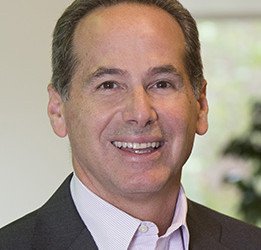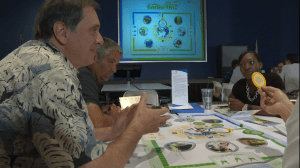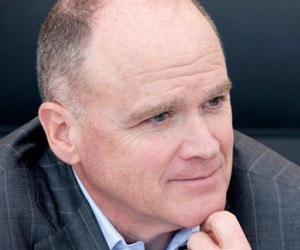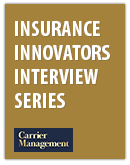Strategy games, an Innovation Garage, an analysis of the human brain and just plain “safe environments” in which to cultivate new ideas—those are some of the ways property/casualty insurance leaders say their companies support innovation efforts.
Carrier Management reached out to leaders of P/C insurance companies and service providers, asking them to respond to questions about innovation. Here are the 14 responses to our fourth question, in which we asked about company cultures and strategies to encourage innovation. (Full titles of the executives and the entire list of questions are presented at the bottom of this article, with links to other responses.)
Q4: Describe one or more ways in which your company encourages innovation. (Feel free to describe any elements of the culture or process.)
- Q1: The greatest innovation in the P/C insurance industry
- Q2: Describe the greatest innovation at your company
- Q3: Innovation or innovator outside the insurance industry
- Q4: How your company encourages innovation
- Q5: The biggest obstacle to innovation within the insurance industry?
- Q6: The next innovation to impact the P/C insurance industry
- Q7: Your role in leading innovation.
- Q8: Best book you have read about innovation
- Q9: Describe a failed initiative at your company
- Q10: Collaborating with market competitors
- Q11: Can P/C insurers disrupt other industries?

Sciolla (Gen Re): Over the past 24 months, we’ve embarked on two initiatives to ensure innovation and good decision-making at Gen Re. First, we’ve made an increased investment in the qualitative side of decision-making at Gen Re.
As risk takers, much of our knowledge comes from data, actuarial analysis and models. Yet, that’s only half of what it takes to make a decision or to forge a new path. We also need to acknowledge our subconscious, emotional and biased selves as we seek new opportunities and to be innovators.
For instance, we verify we understand our customer’s strategy and goals, informed by a variety of perspectives, before we begin to discuss possible alternatives and to design a response or product to meet their needs. We check ourselves against “listening to respond” versus “listening to understand the other person’s perspective.”
By addressing biases in our thinking and focusing on being disciplined about thinking, we are more apt to develop both innovative and successful solutions.
Secondly, we have conducted a “cultural” inventory of our company, including a snapshot of our current culture and a description of our ideal culture, both as stated by our employees. We now are working to close the gaps between the current and ideal, which will strengthen Gen Re’s long-term effectiveness as an organization, including our ability to innovate appropriately.

Lupica (ACE): ACE is innovative because we don’t shy away from asking questions and soliciting feedback, which is where all of our innovations begin. It’s the frank conversations with the broker and customer that prompt internal discussion and self-reflection. The reason we’ve experienced such a high success rate with our innovations is because we have a culture at ACE that encourages us to ask the questions, which, in turn, help make things work better for our brokers and clients.
Pratt (Progressive): Progressive is a test-and-learn culture, and over the years, we’ve developed a number of programs to help foster innovation among our employees. One example is our Business Innovation Garage (BIG).

BIG provides Progressive with an internal “lab” to test and learn in such a highly regulated environment like the insurance industry.
Colberg (Assurant): At Assurant, our leadership development programs focus on fostering adaptive leadership skills to unleash the creative potential and tap into the entrepreneurial spirit that exists within our employee talent base. We need to employ innovative thinking to products and related services to best address customers’ evolving needs.
To further stimulate innovation, enhance decision-making skills and engage employees, we launched a strategy learning game at Assurant. The game encourages employees to adopt an enterprise mindset, helping to break down any silos that may exist between departments, and generate new ideas.

Business leaders have reported that the game is helping employees understand the company’s recent strategic decisions, particularly around acquisitions. Prior to playing the game, several employees had asked their managers why the company was making certain acquisitions and whether they were necessary. After playing the game, employees can see how the acquisitions support the company’s overall strategy and how they create new growth opportunities for Assurant. In addition, the game provides an opportunity for senior leaders and front-line employees to sit down at the same table and discuss company strategy.
Some business executives have played the game several times just to hear the discussions among employees and broaden their own perspective of the company.
Assurant is up to nearly 10,000 employees who’ve played the strategy learning game
As another example, we identified a small group of talented employees in their 20s—the NextGen group—and paired them with members of our senior executive team. The NextGen group had the opportunity to “strategize” about potential growth areas to address emerging needs of millennials, which management might never have considered on their own.
Kelley (Ironshore): At Ironshore, we approach product innovation in a systematic manner. Management meets at least once a month, sometimes more often, to update one another on trends within their specialty business lines and to elicit input from our various profit centers. Ironshore’s process for encouraging innovation leads to a culture of collaboration.
Visiting distributing channels throughout our global platform sheds light on marketplace developments and enables us to recognize exposures clients face within an ever-changing insurance landscape. Innovation allows us to help clients adjust to change through a sophisticated approach to introduce and refine products that clients want to purchase.
Wurzler (OneBeacon Technology): At OneBeacon Technology, we are always looking for ways to improve our business, and we encourage our employees to bring new ideas forward. One particular area benefiting from employee innovation has been the renewal cycle. As an example, one of our underwriters suggested revising our rules engine to filter and automate the renewal process. This resulted in a pre-renewal review process that uses computer models to significantly streamline this workflow.
Hendrick (XL Catlin): We have built on our enterprisewide innovation competitions by encouraging individual business units to develop various contests and challenges to get colleagues working together and thinking about new ways to tackle the risks our clients face. But it isn’t just about new products alone. Recently, one of our business units initiated a rapid results initiative (RRI) to quickly find ways that they could improve processes and efficiency in 2015. They received some 125 suggestions, which they are now prioritizing to implement. Innovation takes shape in a lot of different ways and at all levels of XL.
Innovation is continuously stressed in most of our conversations. We all realize that innovation—along with underwriting excellence, analytics, talent and technology—is one of the key drivers that is going to help us reach our goal to achieve top-quintile performance.
McGavick (XL Catlin): The mantra around XL Catlin is “innovation is in our DNA.” XL is the result of industry innovation to address the liability crisis of the 1980s, and that is well-understood at all levels of XL. Innovation has always been part of the culture at XL, but a friendly dose of competition has helped reinforce it, keeping our colleagues excited about innovation. As mentioned earlier, we launched our internal Competition 25 innovation contest to mark an anniversary. It generated a lot of new, actionable ideas, many of which—like our CapAssure product—we brought to market. And that’s the spirit we are trying to keep alive through a variety of means every day.
Lee (AIR Worldwide): Innovation has been a mainstay of AIR’s success over the years. We invented the catastrophe modeling industry back in 1987 and have built on that achievement ever since. (See related article, “Karen Clark Moves to Recreate the Cat Modeling Industry She Founded.”) We were the first to introduce numerical weather prediction (NWP) modeling into our windstorm models, and we were the first to couple global climate models with NWP to assess U.S. flood risk at high resolution.
Innovation is also critical in improving our internal processes. Over the years, we’ve identified many ways to be more efficient, delivering our models and products to clients more quickly and with better quality, and to provide better service to our clients.
The importance of innovation at AIR will only continue to grow as our customers’ demand for analytics becomes more urgent and more sophisticated and as the rate of technological change continues to increase. That’s why we launched our Idea Lab, which creates a forum in which employees from across AIR’s global organization can contribute and exchange ideas, vote on what’s good, and collaborate on seeing them to fruition.
We formally structure our investments in innovation in three distinct categories: new products and services, enhancements to existing products and services, and process improvements.

Ward (Hamilton): Innovation can come from unexpected places in unexpected ways. By having a creative, open and nonjudgmental environment, we try to encourage brainstorming and creative thinking. Our people are intense and competitive, but we also have to be willing to try new things that might not always work. As a leader, one has to ensure that people feel safe enough to try or suggest somewhat controversial ideas. You have to foster trust in you and trust among teammates. (Editor’s Note: Conan Ward is no longer CEO of Hamilton USA.)
Rios (American Modern): Innovation is all about culture. At American Modern, we strive to have a culture that encourages people to speak freely, that is populated by people of diverse backgrounds and points of view, and that is inclusive. That’s how we encourage innovation. You can’t teach it. (Editor’s Note: Manny Rios is no longer CEO of American Modern.)
Lightfoot (Guy Carpenter): Guy Carpenter recognizes we must be able to provide a high level of value to our clients to achieve our business goals. We have a deliberate process to prioritize areas for innovation, but we’ve often found the best ideas come when we challenge ourselves to answer complicated questions from clients. Our culture is dedicated to focusing on client needs, and the work we do to meet those needs inspires our most innovative solutions.

Galanski (Navigators): It is important to create a culture in which employees are encouraged and rewarded for making suggestions and bringing forward new ideas. Many large corporations express a will to innovate, but woe to the employee who actually brings up a new idea. They are tortured by the corporate bureaucracy.
I have found the best source of innovation is spending time with customers— listening to them, to understand their needs and concerns, and then acting upon it. That can occur at any level of a company.
Watson (Argo): Though “innovation” is a buzzword that gets kicked around a lot, at Argo Group it’s one of our core values. We invest a lot of energy in promoting a culture of curiosity, creativity and community. This really is appealing to the high-performers we invite to join us on our journey. When they arrive at Argo Group, it doesn’t take long for them to realize the opportunity. We recognize that no matter what your role is in the organization, everyone has a hidden gem of an idea just waiting to be discovered.
To facilitate such discovery, we have a business unit dedicated solely to innovation and the research and development around it. The team’s charge is to explore new possibilities, leverage emerging technologies and engage our amazing talent to help drive the spirit of innovation throughout the organization. The group is constantly refining the new product development process, launching ideation campaigns and championing an inclusive corporate culture to ensure our business is constantly evolving.
Read more Innovation Insights by Question:
- Q1: The greatest innovation in the P/C insurance industry
- Q2: Describe the greatest innovation at your company
- Q3: Innovation or innovator outside the insurance industry
- Q4: How your company encourages innovation
- Q5: The biggest obstacle to innovation within the insurance industry?
- Q6: The next innovation to impact the P/C insurance industry
- Q7: Your role in leading innovation.
- Q8: Best book you have read about innovation
- Q9: Describe a failed initiative at your company
- Q10: Collaborating with market competitors
- Q11: Can P/C insurers disrupt other industries?
Read more Innovation Insights by Person:
 Stanley A. Galanski, President and CEO, The Navigators Group, Inc.
Stanley A. Galanski, President and CEO, The Navigators Group, Inc. Mark E. Watson III, President and Chief Executive Officer, Argo Group International Holdings, Ltd.
Mark E. Watson III, President and Chief Executive Officer, Argo Group International Holdings, Ltd. Kevin H. Kelley, Chief Executive Officer, Ironshore Inc.
Kevin H. Kelley, Chief Executive Officer, Ironshore Inc. John Wurzler, President, OneBeacon Technology Insurance
John Wurzler, President, OneBeacon Technology Insurance Alan B. Colberg, President and Chief Executive Officer, Assurant, Inc.
Alan B. Colberg, President and Chief Executive Officer, Assurant, Inc. Manny Rios, President and CEO, American Modern Insurance Group
Manny Rios, President and CEO, American Modern Insurance Group Dave Pratt, General Manager, Usage-Based Insurance, Progressive
Dave Pratt, General Manager, Usage-Based Insurance, Progressive Berto Sciolla, EVP and Manager of North American Treaty Reinsurance,Gen Re
Berto Sciolla, EVP and Manager of North American Treaty Reinsurance,Gen Re Greg Hendrick, Chief Executive, Insurance, XL Catlin
Greg Hendrick, Chief Executive, Insurance, XL Catlin Anand Rao, Principal, PwC U.S. Advisory Practice
Anand Rao, Principal, PwC U.S. Advisory Practice Mike McGavick, Chief Executive Officer, XL Catlin
Mike McGavick, Chief Executive Officer, XL Catlin David M. Lightfoot, Managing Director, Head of GC Analytics – Americas, Guy Carpenter
David M. Lightfoot, Managing Director, Head of GC Analytics – Americas, Guy Carpenter Conan Ward, Chief Executive Officer, Hamilton USA
Conan Ward, Chief Executive Officer, Hamilton USA Ming Lee, Chief Executive Officer, AIR Worldwide
Ming Lee, Chief Executive Officer, AIR Worldwide Laura Hay, National Insurance Sector Leader, KPMG LLP
Laura Hay, National Insurance Sector Leader, KPMG LLP John Lupica, Vice Chairman, ACE Group; Chairman, Insurance–North America
John Lupica, Vice Chairman, ACE Group; Chairman, Insurance–North America
Get all 16 interview neatly packaged in a single PDF download. Explore ideas by personality and by question. More than 60 pages of content.






















 Cat Losses, Auto and HO Price Hikes Continue at Allstate
Cat Losses, Auto and HO Price Hikes Continue at Allstate  Study: Average Cyber Breach Insurance Coverage Gap is 350%
Study: Average Cyber Breach Insurance Coverage Gap is 350%  Former MLB Player Charged With Insurance Fraud in Florida
Former MLB Player Charged With Insurance Fraud in Florida  Executives on the Move at AIG, White Mountains, Vermont Mutual
Executives on the Move at AIG, White Mountains, Vermont Mutual 







